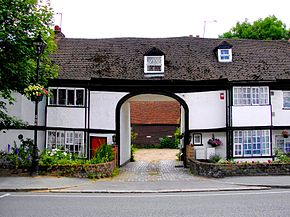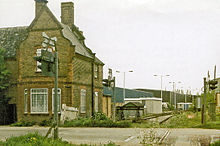Colnbrook
Colnbrook is a small town on the western suburbs of London in England . Together with the village of Poyle it forms the municipality of Colnbrook with Poyle in the district of Slough in Berkshire . The place is located on the main road from London to Bath a few kilometers from Windsor and has been geared towards visitors since its inception. One of the oldest inns in England is in Colnbrook.
Today, the immediate vicinity of London Heathrow Airport characterizes the place. The M25 motorway from London borders the village to the east and the M4 motorway to the west of England borders it to the north. There are a few hotels, many holiday apartments, as well as many car rentals and long-term parking spaces in the village. Several expansion plans for Heathrow Airport in recent years would have destroyed parts of the village if implemented, as new runways and terminals would have been built in the community.
Colnbrook grew the Cox orange apple in the early 19th century , the most popular apple variety in the United Kingdom for several decades.
geography
Colnbrook is located on the Colne Brook River on flat marshland . The main road was originally a dam through the Marsh of the Colne, and it was only over the centuries that the surrounding land around the road was drained and fortified. Colnbrook is 17 miles from central London at the point where the road from London forks: one path heads towards West England, another towards Windsor.
history
Colnbrook is mentioned in the Domesday Book . His oldest inn, the Ostrich , appears in a document from 1106. Due to its location between London and Windsor, English history touched Colnbrook several times. King John Ohneland is said to have stayed in Colnbrook when he was on his way to sign the Magna Carta in Runnymede . Historically, however, is the encampment that the deposed King Richard II set up in Colnbrook in 1400 to march with several thousand men on Windsor and London to recapture his throne. However, Henry IV managed to flee from Windsor to London, where he was able to raise enough troops to beat Richard. Incorporated was Colnbrook in 1543. In 1558, the later Elizabeth I was briefly kept in Colnbrook at the George Inn when she was taken prisoner to Hampton Court Palace .
During the English Civil War, Colnbrook was the location of various troops several times. Ruprecht von der Pfalz, Duke of Cumberland , set up quarters here in 1642 before attacking parliamentary troops. Ruprecht used this opportunity to plunder the city and capture wealthy citizens. In 1643 Arthur Capell, 1st Baron Capell of Hadham , the Earl of Essex, used Colnbrook as a base to terrorize Gloucester . In 1647, the general of the parliamentary troops, Thomas Fairfax, used Colnbrook as a base camp, in order to possibly advance further to London from there. At the end of the 17th century, Colnbrook's residents were victims of a plague epidemic.
Methodist founder John Wesley, on the other hand, who noted his stay in Colnbrook in his diaries in 1747, was so unimpressed by the place that he did not even remember its exact name. Colnbrook has long been a street village that consisted of a single street. Four bridges crossed the four arms of the Colne River.
At the beginning of the 19th century, the retired brewer Richard Cox moved from Bermondsey to Colnbrook and bought two acres of land with orchards in the Lawns . In this land he grew various apples. This resulted in the Cox Pomona cooking apple and the Cox Orange apple variety . This became known nationwide with the help of the Colnbrook gardener David Small and his son James Small and in the 20th century it developed into the most popular apple variety in England and one of the few globally traded varieties. In Colnbrook itself only several Cox apple trees in the local park and three benches in the shapes of “C”, “O” and “X” remind of this.
At the end of the 19th century, Colnbrook was a typical example of a surviving tourist town in England. After the carriage was no longer the most important means of transport, the hotels and inns in the village fell into disrepair and the remaining hostels had few customers, as the place was too far from London to benefit from the capital's rapid growth.
Between 1965 and 1980, the McLaren Racing motorsport team was based in Colnbrook before moving a few kilometers further south to Woking . In 1985 and 1986, the Formula 1 racing team Team Haas (USA) had its premises here.
Cityscape
The street village is mainly characterized by the main street, the former main connection between London and Bath. There are still numerous inns from different centuries on it. The church is a bit out of the way, as is the Strict Baptists' chapel.
Churches
The neo-Gothic St Thomas Church was built in several stages between 1848 and 1889 with an active Anglican congregation. The adjacent rectory and the former school with the director's house also date from the 19th century (1853–1858) and represent some of George Edmund Street's first experiments with polychrome surface design on his buildings.
On the main street is a modern church building shared by Methodists and the United Reformed Church . This goes back to parishes and their church buildings, each from the first half of the 19th century. At the end of the 20th century, the congregations agreed to build a new place of worship and opened the current church in 1990. The Strict Baptists' chapel is also on the main street . The red and yellow brick building dates from 1871 to 1872.
Hotels and inns
Due to its location, Colnbrook has always been an important traffic place. In the 16th century there were already 10 Coach Inns where travelers could stop off on the road between London and the English south-west.
The oldest inn in Colnbrook is the Ostrich , which can trace its history back hundreds of years to 1106 and is now the third oldest inn in the United Kingdom. It is located in a half-timbered house from the late 16th century. Documents prove the existence of an inn at this location in 1106. In the 17th century a landlord killed several of his guests by dropping them directly into a kettle of boiling water with a trap door under the bed. The landlord was particularly interested in the gold that the traders carried with them to buy precious fabrics and textiles in the west of England. The incident is said to have inspired the story of Sweeney Todd and led to the Ostrich Inn being considered haunted to this day.
Other inns in Colnbrook that have existed for several centuries are the 16th century Star & Garter and the 19th century Ye Olde George Inn and Park House with some 16th century components. In addition to various guest houses, the Hilton Heathrow Terminal 5 and the Holiday Inn Express T5 are also located in the municipality.
Other places
In Colnbrook there is a go-kart track, F1 Karting West London . The Colnbrook Immigration Removal Center , an institution to detain refugees before they are deported, is not in Colnbrook, but in Harmondsworth , a place just east of Colnbrook, which is still part of London. The Colnbrook Incinerator, a waste incineration plant built in 2011 , is located on the municipal area.
Politics and administration
Colnbrook lies on the border of several larger administrative units. The London Borough of Hillingdon borders directly to the east of Colnbrook with Poyle . The village itself has changed its territory several times and was at times divided into several areas at the same time. In the 19th century, for example, the Colne formed the border between Buckinghamshire and Middlesex , so that the border divided the place. After the dissolution of Middlesex in 1964, the border between Buckinghamshire and Surrey ran through the place. After the 1995 administrative reform that merged Colnbrook and Poyle into one parish, both now belong to Berkshire .
In the 18th century, the place formed a constituency for the English lower house and sent its own member of parliament.
traffic
Colnbrook is directly adjacent to the M25, M4 and London Heathrow International Airport, but can only be reached by public transport by bus. Since the opening of the Colnbrook Bypass in 1929, the main route between London and the west of Great Britain no longer goes directly through Colnbrook. Colnbrook Station, opened in 1884, was on the Great Western Railway and was closed in 1963 due to the Beeching Report .
literature
- Colnbrook , in: William Page (Ed.): A History of the County of Buckingham , Vol. 3, 1925. pp. 246-249.
Web links
Individual evidence
- ^ A b c d e f Charles G. Harper: The Bath Road: History, Fashion & Frivolity on an Old Highway . Chapman & Hall, London 1899. (Chapter Colnbrook)
- ^ A b Buckinghamshire in: Society for the Difussion of Useful Knowledge (Ed.): The Penny Cyclopaedia of the Society for the Difussion of Useful Knowledge 1836, Vol. 5
- ↑ a b c d e Potted Chronology ( Memento of the original from May 18, 2013 in the Internet Archive ) Info: The archive link was inserted automatically and has not yet been checked. Please check the original and archive link according to the instructions and then remove this notice. , Colnbrook.info
- ↑ Thomas Glemham: Life in the 17th Century ( page no longer available , search in web archives ) Info: The link was automatically marked as defective. Please check the link according to the instructions and then remove this notice.
- ↑ Chronology of the First Civil War - 1643 ( Memento of the original from October 21, 2013 in the Internet Archive ) Info: The archive link was inserted automatically and has not yet been checked. Please check the original and archive link according to the instructions and then remove this notice.
- ↑ Oliver Cromwell: Memoirs of the Protector, Oliver Cromwell Longman, Hurst, Rees, Orme, and Brown, 1822 p. 206
- ↑ a b A history of colnbrook and poyle united church ( Memento of the original dated May 30, 2014 in the Internet Archive ) Info: The archive link was inserted automatically and has not yet been checked. Please check the original and archive link according to the instructions and then remove this notice. , Thames Valley Methodist Circuit
- ↑ Christopher Stocks: Forgotten Fruits: The stories behind Britain's traditional fruit and vegetables Random House, 2009 ISBN 1409061973 p. X
- ↑ a b c d Nikolaus Pevsner, Elizabeth Williamson, Geoffrey K. Brandwood: Buckinghamshire: Buildings of England - Pevsner Architectural Guides Yale University Press, 1994 ISBN 0-300-09584-8 pp. 260-261
- ↑ Colnbrook, St Thomas , Church of England
- ↑ Colnbrook & Poyle United Church , Thames Valley Methodist Circuit
- ↑ Welcome to Colnbrook.com , Colnbrook.com
- ^ Colnbrook , Berkshire Brewery Company
- ^ F1 Karting South East , day out with the kids
- ↑ site of Colnbrook Removsal Center
- ^ Slough Library: Colnbrook Station, London Road, Colnbrook, Slough. About 1920. , Slough History Online
Coordinates: 51 ° 29 ′ 1 ″ N , 0 ° 31 ′ 26 ″ W.






